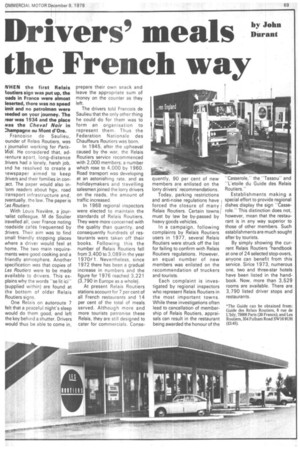Drivers' meals the French way
Page 71

If you've noticed an error in this article please click here to report it so we can fix it.
by John Durant
NHEN the first Relais loutiers sign was put up, the 'oads in France were almost leserted, there was no speed imit and no patrolmen were seeded on your journey. The rear was 1934 and the place as the Cheval Noir in :hampagne au Mont d'Ore.
Francoise de Saulieu, ounder of Relais Routiers, was journalist working for ParisWidi. He considered that, adtenture apart, long-distance drivers had a lonely, harsh job, )nd he resolved to create a -iewspaper aimed to keep drivers and their families in con:act. The paper would also in'orm readers about hgv, road transport infrastructure and, 3ventually, the law. The paper is r_es Routiers.
With Louis Naviere, a jourialist colleague, M de Soulier travelled all, over France noting roadside cafés frequented by drivers. Their aim was to find small friendly stopping places vvhere a driver would feel at home. The two main requirements were good cooking and a friendly atmosphere. Another specification was that copies of Les Routiers were to be made available to drivers. This explains why the words "se lit id" (supplied within) are found at the bottom of older Relais Routiers signs.
One Relais on autoroute 7 felt that a peaceful night's sleep would do them good, and left the key behind a shutter. Drivers would thus be able to come in, prepare their own snack and leave the appropriate sum of money on the counter as they left.
The drivers told Francois de Saulieu that the only other thing he could do for them was to form an organisation to represent them. Thus the Federation Nationale des Chauffeurs Routiers was born.
In 1945, after the upheaval caused by the war, the Relais Routiers service recommenced with 2,000 members; a number which rose to 4,000 by 1960. Road transport was developing at an astonishing rate, and as holidaymakers and travelling salesmen joined the lorry drivers on the roads, the amount of traffic increased.
In 1968 regional inspectors were elected to maintain the standards of Relais Routiers. They were more concerned with the quality than quantity, and consequently hundreds of restaurants were taken off their books. Following this the number of Relais Routiers fell from 3,400 to 3,089 in the year 1970f 1. Nevertheless, since 1972 there has been a gradual increase in numbers and the figure for 1976 reached 3,221 (3,790 in Europe as a whole).
At present Relais Routiers stations account for 7 per cent of all French restaurants and 14 per cent of the total of meals served. Although more and more tourists patronise these Relais, they are still designed to cater for commercials. Conse quently, 90 per cent of new members are enlisted on the lorry drivers' recommendations.
Today, parking restrictions and anti-noise regulations have forced the closure of many Relais Routiers. Certain towns must by law be by-passed by heavy goods vehicles.
In a campaign, following complaints by Relais Routiers users in 1977, several Relais Routiers were struck off the list for failing to confirm with Relais Routiers regulations. However, an equal number of new members was enlisted on the recommendation of truckers and tourists.
Each complaint is investigated by regional inspectors who represent Relais Routiers in the most important towns. While these investigations often lead to cancellation of membership of Relais Routiers, appraisals can result in the restaurant being awarded the honour of the "Casserole," the "Tassou" and "L'etoile du Guide des Relais Routiers."
Establishments making a special effort to provide regional dishes display the sign "Casserole." This distinction does not, however, mean that the restaurant is in any way superior to those of other members. Such establishments are much sought after by tourists.
By simply showing the current Relais Routiers *handbook at one of 24 selected stop-overs, anyone can benefit from this service. Since 1973, numerous one, two and three-star hotels have been listed in the handbook. Now, more than 3,529 rooms are available. There are 3,790 listed driver stops and restaurants.
































































































































